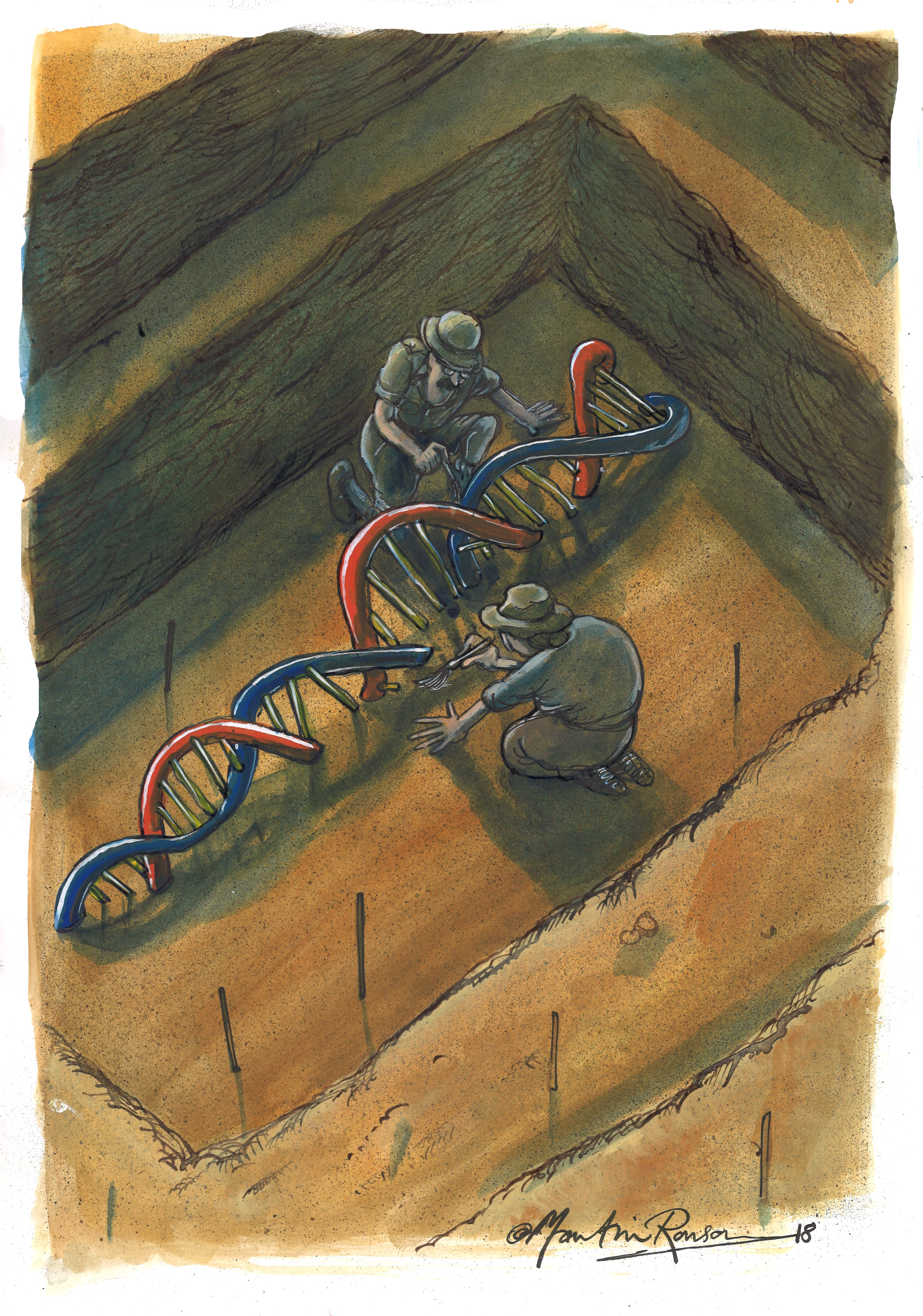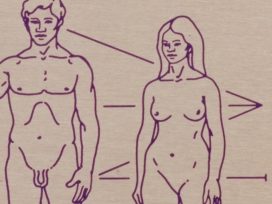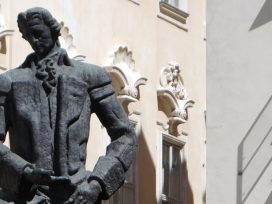The study of prehistory – roughly everything before 5,000 years ago – began by grubbing in the earth for the remains of settlements and goods and bones and fossils. Before that, there was the geological record with a time frame crudely assessed by comparing strata and estimating sedimentation rates. All this changed with radioactive dating, invented by the great physicist Ernest Rutherford in 1905. First, it impacted geology, giving us an accurate time frame for the history of the earth, and then for the fossil record of early Homo sapiens, now dated to around 300,000 years ago. In 1949 came radiocarbon dating, which gives us a date for when living things died. Although it is effective for only up to 50,000 years, it revolutionised the study of the more recent past. Archaeologists had dates for their settlements, pots and ancient human samples.

Image: Copyright Martin Rowson; used with author’s permission
Now, scientists can analyse ancient DNA – which is where David Reich comes in. A Harvard geneticist, Reich’s pioneering work is rewriting human prehistory. His book Who We Are and How We Got Here contains startling new findings across the whole period of human evolution, heralding a new era of human understanding of our own place in the world. Reich is an urbane and affable 45-year-old, the model of the modern professor. History was his first passion; he started with social studies at Harvard, switched to physics, then began but didn’t finish a PhD in biochemistry at Oxford. He was clearly searching for something. All these disciplines suddenly added up when he began to work in medical genetics and then in ancient genetics.
Ancient DNA studies began around 20 years ago, but the field was small. Sequencing was slow and expensive, the samples – from small quantities found in well-preserved specimens – were few, and they were hard to purify after thousands of years of contamination by bacteria. After an ‘apprenticeship’ with ancient DNA pioneer Svante Pääbo at Leipzig in 2007, Reich set up his own lab at Harvard in 2013, where he created a ‘genomics factory’, industrialising the analysing process and sequencing hundreds of samples in a single study. Reich works with large collaborative teams across global universities but he is the acknowledged leader. In 2015 he was named by Nature magazine as one of 10 scientists of the year.
It is the industrial scale of Reich’s work that enables startlingly precise conclusions to be drawn about prehistory. By the end of 2015, more than half the world’s ancient DNA sequences came from his lab. That’s the quantity – but what are the implications for understanding both the world before history began and our current position?
‘Pots are not people’ has been inscribed across archaeology departments for decades; meaning that a new style of pots appearing somewhere at a certain time could be the result of cultural adoption or trade rather than a new people with a different culture muscling in. Similarly with language: French, Italian, Spanish and Portuguese are clearly derived from Latin but not necessarily because these people are genetic descendants of the Romans. Latin was forced upon these populations by a ruling elite.
Yet the finding that most European languages, some Iranian languages and most northern Indian languages have a common ancestor has puzzled many since 1786, when an English civil servant working in India realised that ancient Sanskrit was related to Latin and Greek. So began the study of the Indo-European language family now spoken by half the world’s people. In 2015, Reich’s team identified the source of the westward spread of the Indo-European languages, from 5,000 years ago, as the steppe, the vast grassland plains stretching thousands of miles across eastern Europe and Asia. More specifically, it was traced to the Yamnaya, situated in modern-day Russia, north of the Caspian and Black Seas. Its ancient population consisted of animal-herding, horse-riding and chariot-driving nomads. In a forthcoming paper, Reich’s team will present ancient DNA data on the north Indian and Iranian migrations, confirming the link between the Yamnaya and the transmission of Indo-European languages to both east and west. A centuries-old mystery has been solved.
The Indo-European question is not just about language. Until DNA evidence was added to the picture, archaeologists and linguists struggled to understand past cultural changes. For decades, theories of past migrations were generally rejected, not least because of the vicious use the Nazis made of the myth of the Aryans. The Nazis identified with the founders of the Indo-European language and decided that they originated in Germany; they even used this as a claim on the territories of Poland and Czechoslovakia. Now, Reich’s work has revealed the source to be the Yamnaya, a place, Reich notes, ‘that German nationalists would have despised as a source.’
Lest anyone should want to use Reich’s findings to launch a new racist myth, his work across the globe documents many surprising movements and replacements of populations: the people in any place now are generally not related to the people who were there in the past. Drawing a sense of identity from ancient people who happened to have been on your patch or who at some time migrated to your patch is a futile endeavour. Reich concludes ‘ideologies that seek a return to a mythical purity are flying in the face of hard science.’
How is he able to draw these conclusions? The idea that DNA can inform us about our past movements first emerged with DNA fingerprinting. Our genes are inherited in blocks, complete with many little accidental, harmless variations as well as some mutations. These quirks in DNA were first used to pinpoint criminal individuals. Then, it became possible to chart not crimes but past movements of large populations. Communities that have lived in the same locale for some length of time invariably share much of their genetic ancestry. And if such a group migrates to somewhere else their genetic signal shows up in the new location.
DNA is informative over the whole period of human evolution. One of Reich’s first pieces of research, in 2006, was to compare the chimp and human genomes. He was able to date the divergence from a common ancestor to somewhere between 6.3 and 5.4 million years ago. This wasn’t an ancient DNA study but a comparison of living human and chimp genomes. The first major study of a whole human ancient genome, on which Reich worked with Svante Pääbo, in 2009, produced the discovery that Homo sapiens in Europe and Asia had interbred with Neanderthals.
Besides the Indo-European migrations, his studies have helped to show that the standard ‘Out of Africa’ theory of Homo sapiens’ evolution needs revision because of that interbreeding with Neanderthals and other archaic humans. His latest paper shows that in Britain around 4,500 years ago, post-Stonehenge, 90 percent of the population was replaced by migrants, the Bell Beaker culture, who were the westernmost wave of the Yamnaya migrations.
Archaeologists are delighted with this cornucopia of data from ancient DNA, but some social scientists are not. In March, 67 of them published an open letter on Buzzfeed. They were exercised not by the ancient DNA work but by some thoughts in the book about present-day populations. The danger zone they highlight relates to the potential application of ancient DNA studies to the historical period. This is more complicated because the human population is much larger than in the past and people move around in a more disorderly way. Nevertheless, genomic analysis can be applied to present-day populations. In the book, Reich discusses the prospect that this kind of work will inevitably reveal average differences between populations. In any part of the world, people have adaptations to their environment: for example, Tibetans have genes enhanced for breathing rarefied air at altitude; such differences are obvious and uncontested. But the challenge of different environments means that different cognitive abilities will also be favoured.
Reich acknowledges a risk of such work being exploited. If there were to be any discrimination against any community on the basis of perceived average genetic difference, ‘that would be a terrible outcome,’ he told me, ‘and it’s something we have to fight against and make illegal, perhaps, as a society. Just as we make illegal discrimination against women for the fact that they might go off and have a baby. But I don’t think the right response is to try to say that these data are not real. We must be optimistic that we can be positive and can handle it like grown-ups.’
The grown-up way is to recognise, as he writes in the book, that ‘for most traits, hard work and the right environment are sufficient to allow someone with a lower genetically predicted performance at some task to excel compared to people with a higher genetically predicted performance.’ Reich’s work is a welcome creative rapprochement between the humanities and science. In the early days geneticists were regarded as making elementary mistakes in archaeology but, as he observes in the book: ‘We geneticists may be the barbarians coming late to the study of the human past, but it is always a bad idea to ignore barbarians.’ Reich is no barbarian; the intellectual joy he takes in mapping prehistory is rooted in the practice of the humanities. Unusually for a scientist, he cites some books rather than papers as his influences: Jared Diamond’s Guns, Germs and Steel; the archaeologist David Anthony’s The Horse, the Wheel and Language which, in 2007, brilliantly marshalled the case for the Indo-European language dissemination from north of the Caspian and Black seas without quite realising the extent of the migrations. Reich lauds the pre-eminent British archaeologist Colin Renfrew’s 1987 book Archaeology and Language (‘a magnificent book, and if my book could endure for as long as his I’d be very happy’). Despite the fact that Reich overturns much of his work, Renfrew has returned the compliment: ‘In just five years the study of ancient DNA has transformed our understanding of world prehistory … David Reich gives the brilliantly lucid first account of the resulting new view of human origins and of the later dispersals which went on to shape the modern world.’ The debate about migration has been settled by scientific evidence.
For all Reich’s boundless belief in his techniques of mapping the course of human history there is one topic on which he is surprisingly, adamantly, negative; in the book he writes: ‘I expect that no intellectually elegant and emotionally satisfying molecular explanation for behavioural modernity will ever be found.’ By ‘behavioural modernity’ he means the way in which Homo sapiens, uniquely in the animal kingdom, developed its endlessly adaptive intelligence; he is saying that the famous search for ‘the gene that made us human’ is futile. I put it to Reich that surely this was an area in which you should never say ‘never’? But he finds the data compelling. ‘If we enter a new environmental or a lifestyle situation, the genetic data seem to be pointing to a scenario in which we already have all the genetic changes we need; the variations at hundreds of places in the genome all rise in frequency to meet the challenge.’
In Reich’s grand vision, we are entering the era of the universally recognised human story. Although he works with sophisticated computer analyses of his data, a recurring theme of our conversation is the importance of a story we can grasp. Reich envisages the equivalent of the globe, the map of the earth that followed from 15th- and 16th-century explorations. The new map will show all the great population movements over time. At present we only have pieces of a jigsaw version but the total map will come: ‘We’ll be able to understand at each place in time the grid samples of all the places people lived, and find what their ancestry was like, their material culture and how those people are related to people nearby. We have to learn to think on a different scale temporally. I actually think that we should be able to hold these things in our head, and have not just geography but a chronology.’
Reich’s work should help us to overcome our innate temporal parochialism. We tend to think that Biblical times, the Greeks, the Romans are very far back, but that is wrong. The human cultural explosion happened within the last 10,000 years in a highly favourable interglacial period. We haven’t yet understood the fortuitousness and fragility of this situation. Our farming and technologies have changed the planet’s ecological balance so much that, instead of heading for the expected next Ice Age, unprecedented warming is occurring. We need Reich’s deep history to deal with the very deep ecological predicament we have created for ourselves. It has come just in time.







